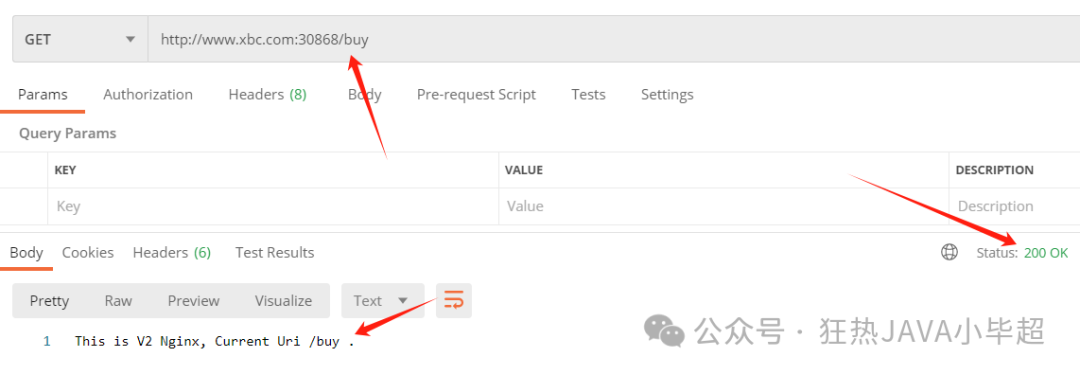1. Istio Traffic Management
Istio is an open-source service mesh that provides a network layer abstraction for distributed microservices architectures. It makes communication between services more reliable and secure, and offers fine-grained traffic management, monitoring, and policy enforcement capabilities. Istio achieves this by inserting a transparent proxy (Envoy) between services to intercept all network communication, allowing developers to focus on business logic without dealing with network issues such as service discovery, load balancing, fault recovery, and security.
The relationship between Istio and k8s is very close. It can leverage the powerful features of k8s to manage and deploy the service mesh. When Istio is deployed in a k8s cluster, it automatically detects services within the cluster and provides them with network layer abstraction. This allows developers to use Istio to manage communication between services while utilizing k8s for service deployment and scaling. This combination makes it easier for developers to build, deploy, and manage complex microservices architectures.
Istio traffic routing rules allow you to easily control traffic between services and API calls. Istio simplifies the configuration of service-level attributes such as circuit breakers, timeouts, and retries, and makes it easy to set up important tasks like A/B testing, canary releases, and staged rollouts based on traffic percentages. It also provides out-of-the-box fault recovery features that enhance application robustness, making it better able to handle failures of dependent services or networks.
Traffic management is one of the core functionalities of Istio, making network layer operations simpler and more flexible. Below is a detailed introduction to the core components and concepts of Istio traffic management:
-
• Envoy Proxy:
Envoyis a high-performanceC++distributed proxy designed for individual services and applications, as well as for large microservices “service mesh” architectures. It is deployed as a sidecar with the service container, intercepting all incoming and outgoing traffic without requiring any changes to the service code.Envoysupports protocols such asHTTP/2andgRPC, and provides features like circuit breakers, anomaly detection, and rate limiting to ensure network stability and reliability. -
• Pilot:
Pilotprovides service discovery functionality forIstio. It converts service configurations from the service directory into configurations forEnvoyproxies and ensures that these configurations are dynamically distributed to allEnvoyproxies at runtime.Pilotabstracts various service discovery systems, such asKubernetesandConsul, allowingIstioto operate in different environments. -
• Mixer:
Mixeris responsible for enforcing access control and usage policies in the service mesh. It allows services to validate request attributes before performing operations and collects telemetry data (such as logs, metrics, and quotas).Mixercommunicates with various backend infrastructures through adapters, such asPrometheus,StatsD, andMySQL. -
• Citadel:
Citadelis responsible for the security features ofIstio, including certificate management, key management, and secure communication between services. It provides automated key and certificate rotation for workloads in the service mesh, ensuring the security of end-to-end communication. -
• Virtual Service: A
Virtual Serviceis anIstioconfiguration resource that allows users to define routing rules to control traffic routing between services. ThroughVirtual Service, users can set up condition matches (such as based on paths orHTTPheaders) and redirect traffic to different versions or services. -
• Destination Rule: A
Destination Ruleworks in conjunction withVirtual Serviceto define traffic policies between service versions, such as load balancing policies, connection pool sizes, circuit breaker settings, etc. -
• Gateway: A
Gatewayis anIstioconfiguration resource used to manage ingress and egress traffic in the service mesh. It allows users to configure load balancers for the service mesh to handle traffic from external networks. -
• Service Entry: A
Service Entryis used to add external services toIstio‘s service directory, allowing services within the mesh to access external services while still leveragingIstio‘s traffic management capabilities.
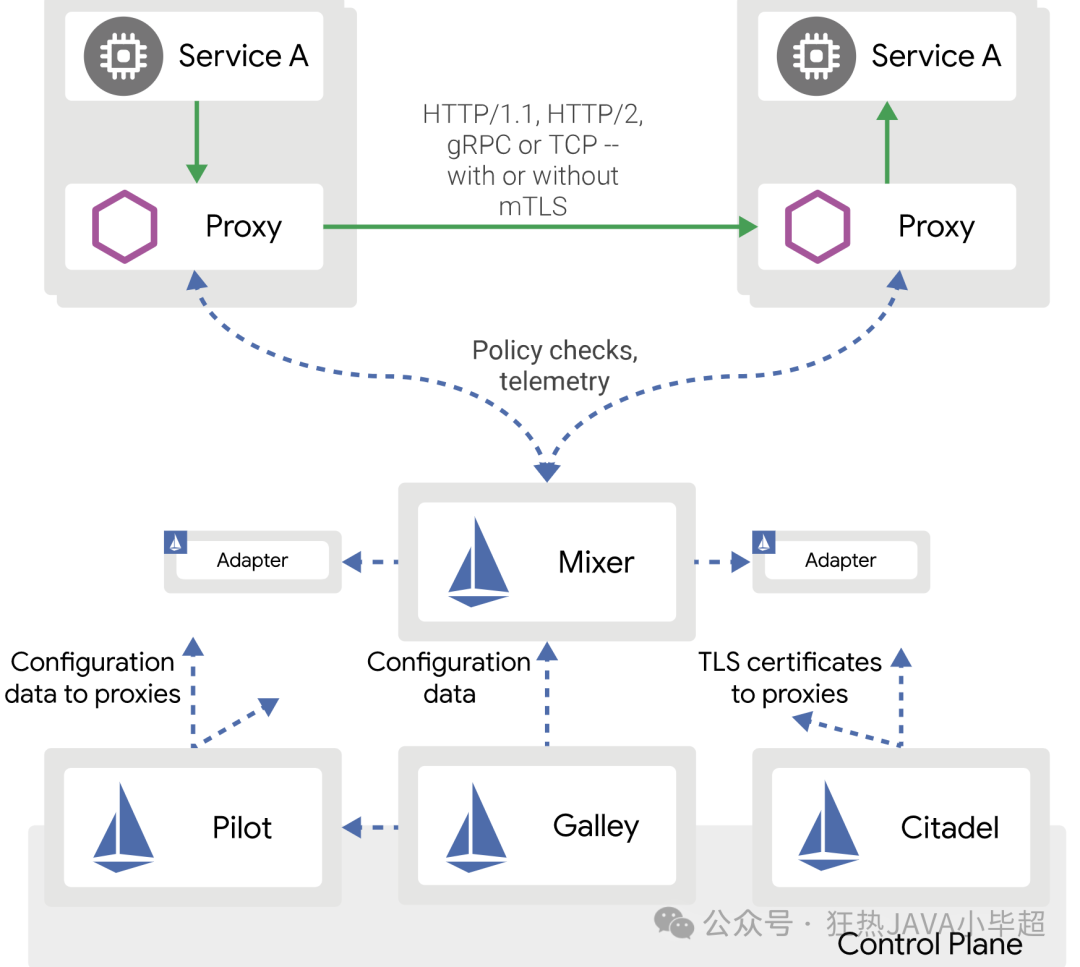
Through these core components and concepts, Istio provides a unified way to manage, protect, and monitor traffic between microservices, allowing developers to focus on business logic rather than network issues.
The official documentation is as follows:
https://istio.io/latest/en/docs/concepts/traffic-management/
1.1 Installing the Istio Environment
Download the istioctl client tool:
curl -L https://istio.io/downloadIstio | sh -Add the istioctl client tool to your environment variables:
cd istio-1.21.2/
export PATH=$PWD/bin:$PATHTest the environment by checking the version of istioctl:
istioctl version
Use istioctl to install the istio environment, provided that the current machine already has a k8s environment.
istioctl install --set profile=demo -yThe available profile options are as follows:
-
•
default: Starts components based on the default settings of theIstioOperator API. Recommended for production deployments and as thePrimary ClusterinMulticluster Mesh. You can runistioctl profile dumpto see the default settings. -
•
demo: This configuration has moderate resource requirements and is designed to showcaseIstio‘s capabilities. It is suitable for running theBookinfoapplication and related tasks. This profile enables high-level tracing and access logging, so it is not suitable for performance testing. -
•
minimal: Similar to the default profile, but only installs control plane components. It allows you to useSeparateProfileto configure control plane and data plane components (such asGateway). -
•
remote: Configures theMulticluster Meshfor theRemote Cluster. -
•
empty: Deploys nothing. Can serve as a base profile for custom configurations. -
•
preview: The preview file contains experimental features. This is for exploring new features ofIstio. Stability, security, and performance are not guaranteed (use at your own risk).
After successful installation, check the Istio pod:
kubectl get pods -n istio-system
If the status is Running, it is normal. You can see that the ingress and egress gateways are installed. These two gateways actually run an Envoy proxy instance at the edge of the mesh as load balancers. The ingress gateway receives incoming connections, while the egress gateway receives connections going out from the cluster.
Create a namespace to operate all subsequent actions within that namespace:
kubectl create ns testAdd a label to this namespace to indicate that the Envoy sidecar proxy should be automatically injected during application deployment:
kubectl label namespace test istio-injection=enabled1.2 Testing the Istio Environment
In the Istio service mesh, traffic routing rules can be defined through VirtualService, and traffic can be accessed through GateWay. Below is a case to test whether the environment is functioning normally.
Start an Nginx as the target service, creating interfaces /, /buy, /order, and /err for different scenarios:
vi nginx-v1.ymlapiVersion: v1
kind: Service
metadata:
name: nginx-v1
namespace: test
labels:
app: nginx-v1
spec:
type: ClusterIP
ports:
- port: 80
targetPort: 80
selector:
app: nginx-v1
---
apiVersion: v1
kind: ConfigMap
metadata:
name: nginx-v1-config
namespace: test
data:
nginx.conf: |-
events {
use epoll;
worker_connections 65535;
}
http {
include mime.types;
server_tokens off;
client_max_body_size 50m;
server {
listen 80;
server_name localhost;
proxy_buffering off;
autoindex on;
add_header Access-Control-Allow-Origin '*';
proxy_connect_timeout 1800s;
proxy_send_timeout 1800s;
proxy_read_timeout 1800s;
location / {
return 200 "This is V1 Nginx.";
}
location /buy {
return 200 "This is V1 Nginx, Current Uri /buy .";
}
location /order {
return 200 "This is V1 Nginx, Current Uri /order .";
}
location /err {
return 500 "This is V1 Nginx, Current Uri /err .";
}
}
}
---
apiVersion: apps/v1
kind: Deployment
metadata:
name: nginx-v1
namespace: test
spec:
selector:
matchLabels:
app: nginx-v1
replicas: 1
template:
metadata:
labels:
app: nginx-v1
name: nginx
version: v1
spec:
containers:
- name: nginx-v1
image: nginx:1.20.1
ports:
- containerPort: 80
volumeMounts:
- name: nginx-config
mountPath: /etc/nginx/nginx.conf
subPath: nginx.conf
volumes:
- name: nginx-config
configMap:
name: nginx-v1-configkubectl apply -f nginx-v1.ymlCheck the Pod:

There are two containers here because one is the sidecar and the other is the nginx target service.
Next, create a Gateway and VirtualService to test traffic forwarding:
vi nginx-gwvs.ymlapiVersion: networking.istio.io/v1alpha3
kind: Gateway
metadata:
name: nginx-gw
namespace: test
spec:
selector:
istio: ingressgateway # use istio default controller
servers:
- port:
number: 80
name: http
protocol: HTTP
hosts:
- "*"
---
apiVersion: networking.istio.io/v1alpha3
kind: VirtualService
metadata:
name: nginx-vs
namespace: test
spec:
hosts:
- "*"
gateways: #bind gateway
- nginx-gw
http:
- route: #route
- destination:
host: nginx-v1.test.svc.cluster.local
port:
number: 80kubectl apply -f nginx-gwvs.ymlCheck the port of the gateway nodeport:
kubectl get svc -n istio-system
Access: http://{node ip}:30868/
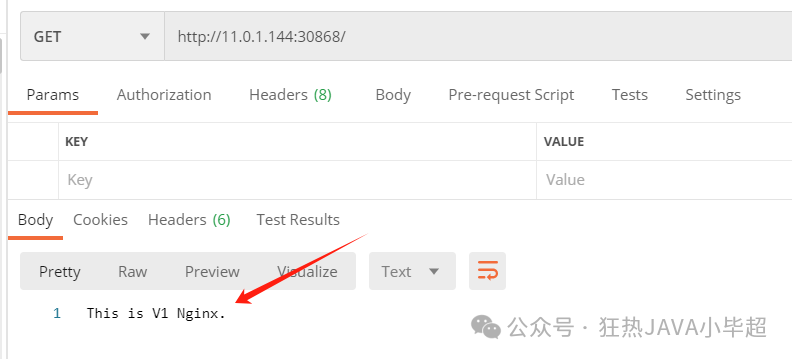
Use the following command to check the logs of the ingressgateway:
kubectl logs -f -n istio-system -l istio=ingressgateway
Next, we will start a more detailed usage introduction.
2. VirtualService Traffic Management
Istio‘s VirtualService is a core configuration resource that allows users to control data flow in the service mesh by defining a set of traffic routing rules. These rules can route traffic to different service versions or destinations based on request attributes (such as paths, headers, query parameters, etc.), while supporting features like redirects, rewrites, fault injection, timeouts, retry policies, and traffic mirroring. These features make it simple and flexible to achieve fine-grained traffic management in complex microservices environments.
Below are important configuration items in VirtualService:
| Configuration Item | Description |
| spec.hosts | Defines a set of hosts associated with routing rules, which can be wildcard DNS names or IP addresses. |
| spec.gateways | Defines the source traffic for applying routing rules, which can be one or more gateways, or sidecars within the mesh, specified as <gateway namespace>/<gateway name> |
| spec.http.match | Defines a list of matching rules for routing, where all conditions within a single match rule are AND relationships, while multiple match rules in the list are OR relationships. |
| spec.http.route | Defines a list of forwarding destinations for the HTTP route, which can be a redirect or forwarding (default). The forwarding destination can be one or more services (service versions). It can also configure weights, header operations, etc. |
| spec.http.redirect | Defines routing redirection; an HTTP route can be either a redirect or forwarding (default). |
| spec.http.rewrite | Defines rewriting, which cannot be configured simultaneously with redirection; rewrite operations will be executed before forwarding. |
| spec.http.timeout | Defines the timeout for HTTP requests. |
| spec.http.retries | Defines the retry policy for HTTP requests. |
| spec.http.fault | Defines the fault injection policy for HTTP traffic; when enabled, timeout and retry policies will not be active. |
| spec.http.mirror | Defines the mirroring of HTTP traffic to another specified destination. |
| spec.http.mirrorPercent | Defines the percentage of traffic to be mirrored; by default, 100% of the traffic is mirrored. The maximum value is 100. |
| spec.http.corsPolicy | Defines the CORS policy. |
| spec.http.headers | Defines header operation rules, allowing updates to request and response header, including adding and removing operations. |
2.1 Restricting Request Domains
apiVersion: networking.istio.io/v1alpha3
kind: Gateway
metadata:
name: nginx-gw
namespace: test
spec:
selector:
istio: ingressgateway # use istio default controller
servers:
- port:
number: 80
name: http
protocol: HTTP
hosts:
- "www.xbc.com"
---
apiVersion: networking.istio.io/v1alpha3
kind: VirtualService
metadata:
name: nginx-vs
namespace: test
spec:
hosts:
- "www.xbc.com"
gateways: #bind gateway
- nginx-gw
http:
- route: #route
- destination:
host: nginx-v1.test.svc.cluster.local
port:
number: 80Update the configuration:
kubectl apply -f nginx-gwvs.yml Access again using http://{node ip}:30868/:

At this point, a 404 is returned. Add a domain mapping in hosts:
11.0.1.144 www.xbc.comUsing the domain, access is successful:
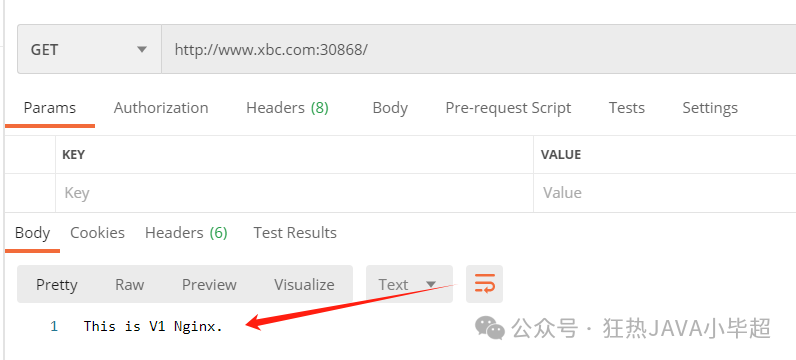
2.2 Match Rule Matching
Supports operations on uri, scheme, method, and authority, each type supports exact, prefix, and regex matching modes.
For example:
2.2.1 Routing by URI Prefix
apiVersion: networking.istio.io/v1alpha3
kind: VirtualService
metadata:
name: nginx-vs
namespace: test
spec:
hosts:
- "www.xbc.com"
gateways:
- nginx-gw
http:
- match:
- uri:
prefix: /buy
route:
- destination:
host: nginx-v1.test.svc.cluster.local
port:
number: 80When the uri has the prefix buy, it can be accessed normally:
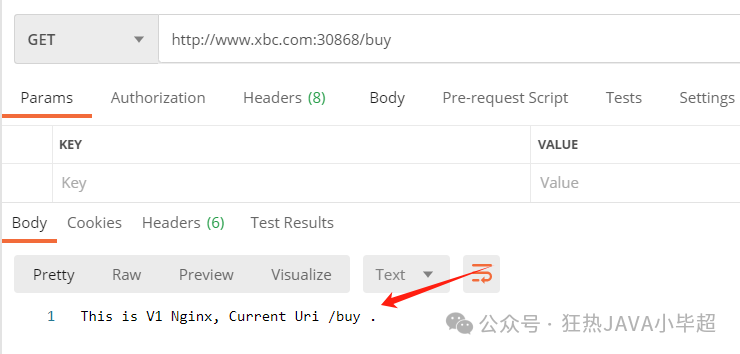
If accessing the order interface, it will not be accessible:

2.2.2 Routing by Header Parameter
apiVersion: networking.istio.io/v1alpha3
kind: VirtualService
metadata:
name: nginx-vs
namespace: test
spec:
hosts:
- "www.xbc.com"
gateways:
- nginx-gw
http:
- match:
- headers:
userid:
exact: test
route:
- destination:
host: nginx-v1.test.svc.cluster.local
port:
number: 80Only requests with header containing userid=test can access. If the header parameter is not added, a 404 will be returned:
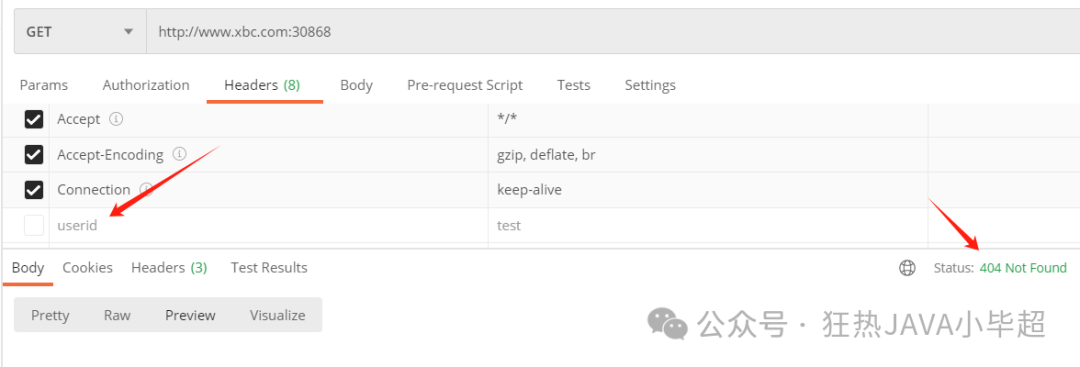
Accessing with the header parameter can be done normally:
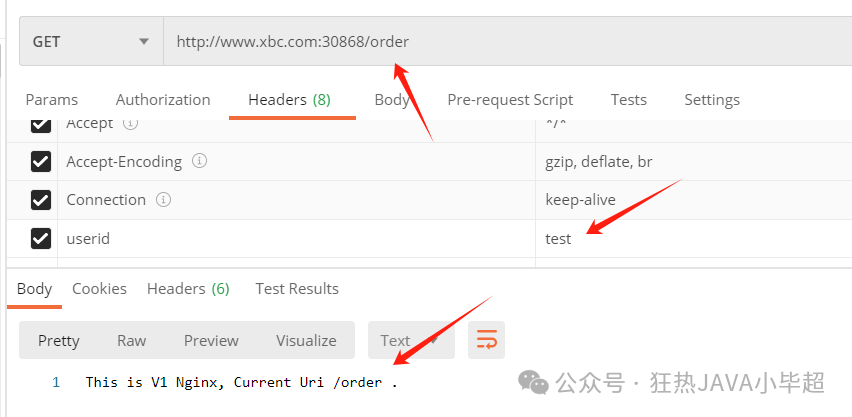
2.2.3 Mixing Multiple Rules
apiVersion: networking.istio.io/v1alpha3
kind: VirtualService
metadata:
name: nginx-vs
namespace: test
spec:
hosts:
- "www.xbc.com"
gateways:
- nginx-gw
http:
- match:
- headers:
userid:
exact: test
uri:
prefix: /buy
- headers:
userid:
exact: admin
route:
- destination:
host: nginx-v1.test.svc.cluster.local
port:
number: 80
The above means that if the header has a value of userid as test and the uri has a prefix of buy, it can be accessed, or if the header has a value of userid as admin, it can also be accessed.
When the uri has a prefix of buy, but the header has a value of userid as anything else, it will return a 404:

When the uri has a prefix of buy, but the header has a value of userid as test, access is normal:
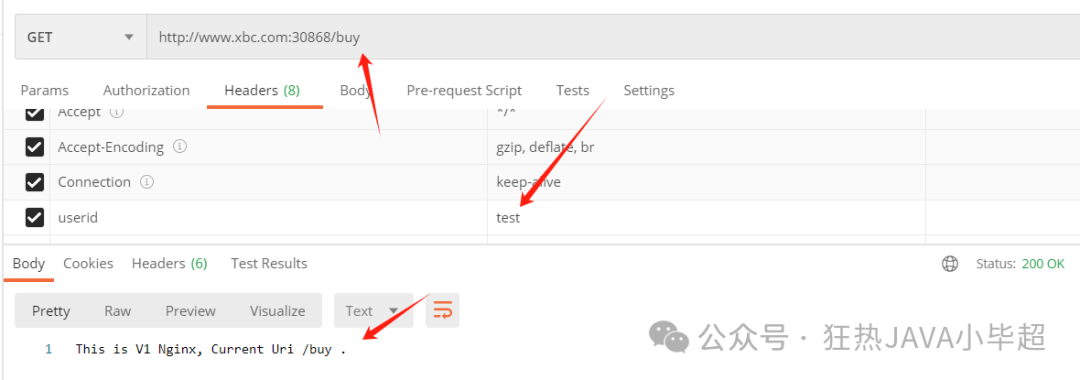
When the uri has a prefix of order and the header has a value of test, it will return a 404:
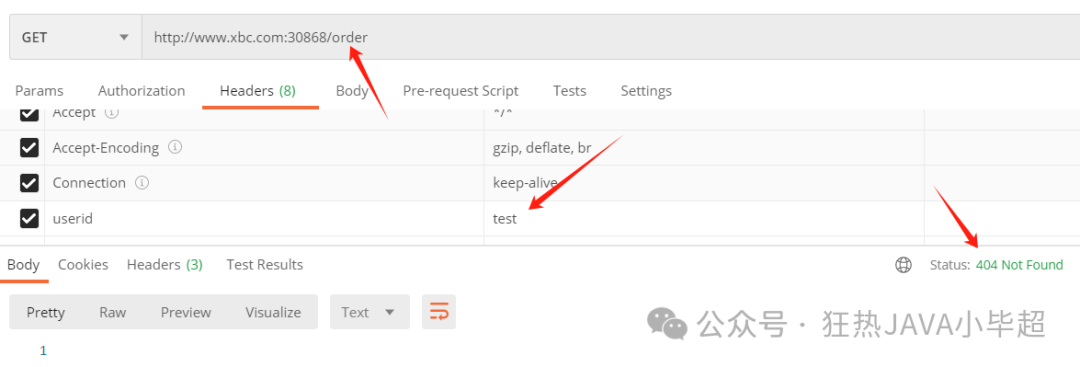
When the uri has a prefix of order and the header has a value of admin, access is normal:
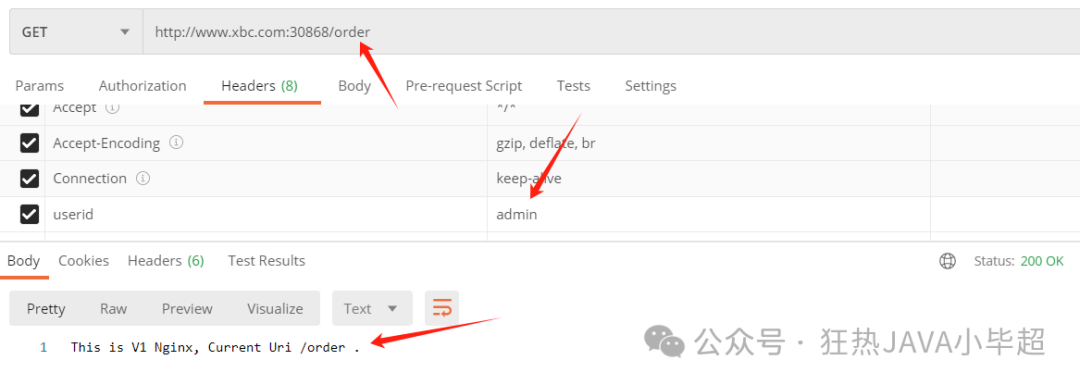
2.3 Route Traffic Transfer
We have already briefly used route to specify the target service. The route has more functionalities, such as implementing load balancing, gray releases, and traffic transfers, with three main configurations: destination (target request), weight (weight), and headers, where destination is mandatory.
To facilitate testing the target route, deploy another nginx v2 version:
vi nginx-v2.ymlapiVersion: v1
kind: Service
metadata:
name: nginx-v2
namespace: test
labels:
app: nginx-v2
spec:
type: ClusterIP
ports:
- port: 80
targetPort: 80
selector:
app: nginx-v2
---
apiVersion: v1
kind: ConfigMap
metadata:
name: nginx-v2-config
namespace: test
data:
nginx.conf: |-
events {
use epoll;
worker_connections 65535;
}
http {
include mime.types;
server_tokens off;
client_max_body_size 50m;
server {
listen 80;
server_name localhost;
proxy_buffering off;
autoindex on;
add_header Access-Control-Allow-Origin '*';
proxy_connect_timeout 1800s;
proxy_send_timeout 1800s;
proxy_read_timeout 1800s;
location / {
return 200 "This is V2 Nginx.";
}
location /buy {
return 200 "This is V2 Nginx, Current Uri /buy .";
}
location /order {
return 200 "This is V2 Nginx, Current Uri /order .";
}
location /err {
return 500 "This is V2 Nginx, Current Uri /err .";
}
}
}
---
apiVersion: apps/v1
kind: Deployment
metadata:
name: nginx-v2
namespace: test
spec:
selector:
matchLabels:
app: nginx-v2
replicas: 1
template:
metadata:
labels:
app: nginx-v2
name: nginx
version: v2
spec:
containers:
- name: nginx-v2
image: nginx:1.20.1
ports:
- containerPort: 80
volumeMounts:
- name: nginx-config
mountPath: /etc/nginx/nginx.conf
subPath: nginx.conf
volumes:
- name: nginx-config
configMap:
name: nginx-v2-configkubectl apply -f nginx-v2.yml2.3.1 Weight-Based Traffic Transfer
By configuring the weight parameter, traffic can be allocated proportionally to different target services.
apiVersion: networking.istio.io/v1alpha3
kind: VirtualService
metadata:
name: nginx-vs
namespace: test
spec:
hosts:
- "www.xbc.com"
gateways:
- nginx-gw
http:
- match:
- uri:
prefix: /
route:
- destination:
host: nginx-v1.test.svc.cluster.local
port:
number: 80
weight: 50
- destination:
host: nginx-v2.test.svc.cluster.local
port:
number: 80
weight: 50The two service versions are allocated 50% of traffic each, and access should demonstrate the load balancing effect:
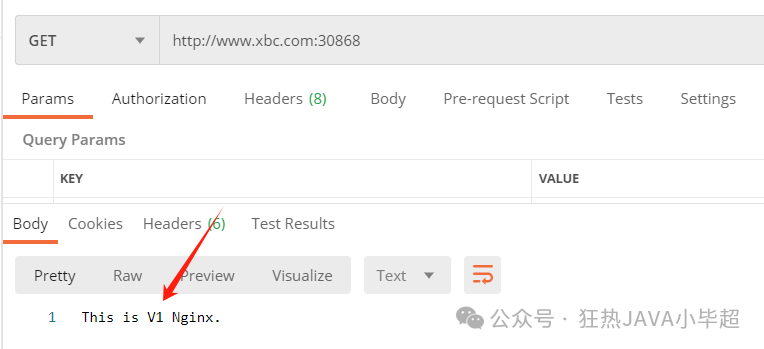
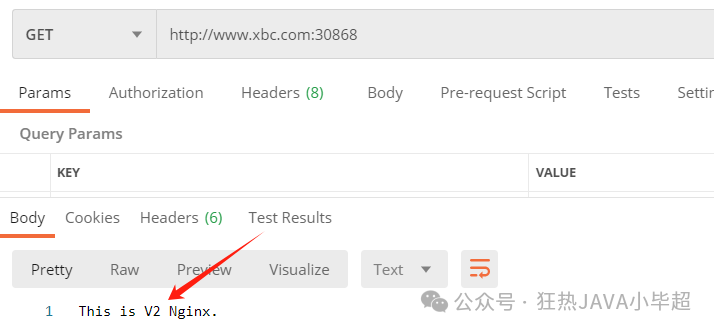
2.3.2 Adding/Modifying Headers
Headers in request or response can be added or modified:
apiVersion: networking.istio.io/v1alpha3
kind: VirtualService
metadata:
name: nginx-vs
namespace: test
spec:
hosts:
- "www.xbc.com"
gateways:
- nginx-gw
http:
- match:
- uri:
prefix: /
route:
- destination:
host: nginx-v1.test.svc.cluster.local
port:
number: 80
headers:
response:
add:
test: xbc
set:
content-type: application/jsonAfter making a request, you can see the added and modified parameters in the returned header:
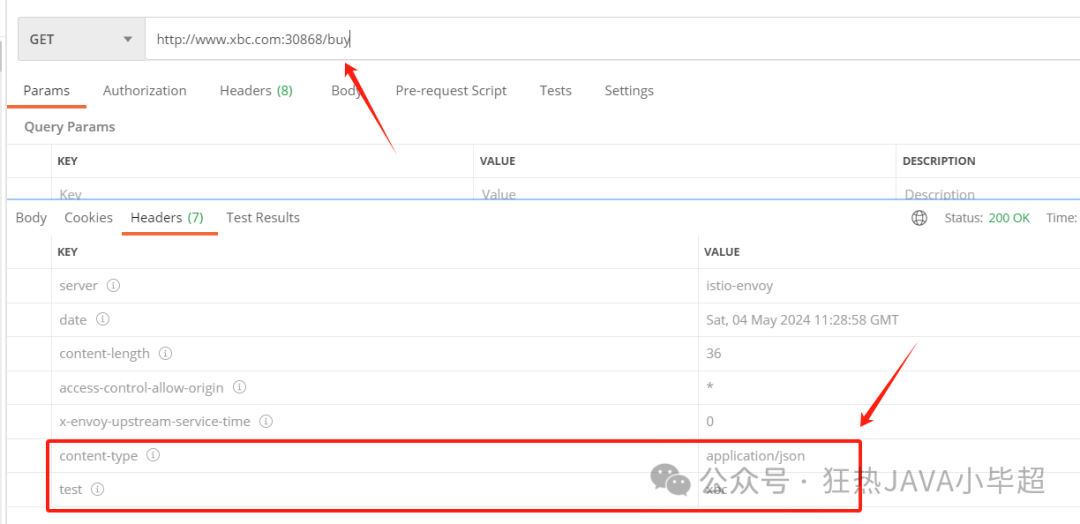
2.4 Redirect
You can redirect from one uri to another uri, returning a 302 status code to the service caller, along with the location in the header for the redirected address.
apiVersion: networking.istio.io/v1alpha3
kind: VirtualService
metadata:
name: nginx-vs
namespace: test
spec:
hosts:
- "www.xbc.com"
gateways:
- nginx-gw
http:
- match:
- uri:
prefix: /buy-v2
redirect:
uri: /buy
route:
- destination:
host: nginx-v1.test.svc.cluster.local
port:
number: 80 The above configuration automatically redirects to the /buy interface when accessing /buy-v2:
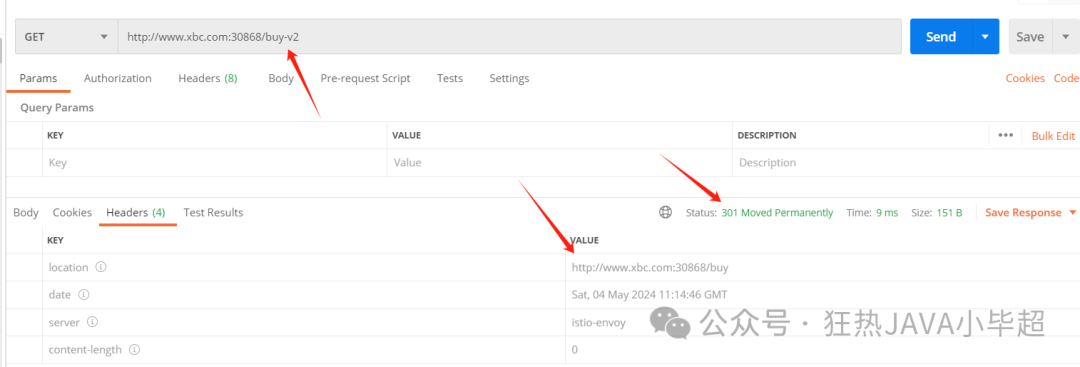
2.5 Rewrite
Similar to the redirect configuration, but rewrites are not visible to the user and occur on the server side.
apiVersion: networking.istio.io/v1alpha3
kind: VirtualService
metadata:
name: nginx-vs
namespace: test
spec:
hosts:
- "www.xbc.com"
gateways:
- nginx-gw
http:
- match:
- uri:
prefix: /buy-v2
rewrite:
uri: /buy
route:
- destination:
host: nginx-v1.test.svc.cluster.local
port:
number: 80 The above configuration rewrites to the /buy interface when accessing /buy-v2, which is not perceived by the service caller:

2.5 Retries
When a request fails, retry policies can be used to attempt to resend, improving service quality.
This mainly includes three parameters: attempts, perTryTimeout, retryOn:
-
• attempts: The number of retries required.
-
• perTryTimeout: The timeout for retries (
ms, s, m, h). -
• retryOn: Retry policy, multiple are separated by commas; strategies include:
-
• 5xx: When the service returns a
5xxstatus code or does not return. -
• gateway-error: Similar to
5xxexceptions but only for502, 503, 504. -
• connect-failure: When the connection to the target service fails.
-
• retriable-4xx: When the target service returns
4xx. -
• refused-stream: When the target service resets with the
REFUSED_STREAMerror code. -
• cancelled: When the
gRPCresponse’sHeaderstatus code iscancelled. -
• deadline-exceeded: When the
gRPCresponse’sHeaderstatus code isdeadline-exceeded. -
• internal: When the
gRPCresponse’sHeaderstatus code isinternal. -
• resource-exhausted: When the
gRPCresponse’sHeaderstatus code isresource-exhausted. -
• unavailable: When the
gRPCresponse’sHeaderstatus code isunavailable.
apiVersion: networking.istio.io/v1alpha3
kind: VirtualService
metadata:
name: nginx-vs
namespace: test
spec:
hosts:
- "www.xbc.com"
gateways:
- nginx-gw
http:
- match:
- uri:
prefix: /
route:
- destination:
host: nginx-v1.test.svc.cluster.local
port:
number: 80
retries:
attempts: 3
perTryTimeout: 3s
retryOn: 5xx,connect-failureThe above defines that when the target service returns 5xx or the connection fails, it will retry a total of 3 times, with a timeout of 3s for each retry.
You can check the logs of nginx-v1 in advance:
kubectl logs -f nginx-v1-dbf758949-bhbdr -n testAccessing the /err interface once will return a 500 error code:

From the nginx-v1 logs, you can see that it was accessed 4 times, including 3 retries.

2.6 Mirror Traffic
Traffic mirroring allows traffic to be forwarded to the target service while also sending a copy of the traffic to another service, which is very helpful for testing new version environments before going live. The configuration parameters are the same as destination:
apiVersion: networking.istio.io/v1alpha3
kind: VirtualService
metadata:
name: nginx-vs
namespace: test
spec:
hosts:
- "www.xbc.com"
gateways:
- nginx-gw
http:
- match:
- uri:
prefix: /
route:
- destination:
host: nginx-v1.test.svc.cluster.local
port:
number: 80
mirror:
host: nginx-v2.test.svc.cluster.local
port:
number: 80The above configuration sends requests to nginx v1 while also sending a request to nginx-v2:
You can check the logs of nginx-v2 in advance:
kubectl logs -f nginx-v1-dbf758949-bhbdr -n test
From the logs of nginx-v2, you can see that it was also requested:

2.7 Fault Injection
Fault injection is a testing technique in the service mesh that allows specific faults to be introduced into the system to simulate network delays or service interruptions. The purpose is to test and improve the resilience and stability of the microservices architecture, ensuring that the system can still handle requests correctly when faced with various real-world problems.
Note: Fault injection should be used cautiously, preferably in a testing environment to avoid unnecessary impacts on the production environment.
Fault injection mainly includes two types: delay and abort:
-
• delay: Used to simulate network delays or service response delays. By introducing delays, you can test the timeout handling, retry mechanisms, and overall performance of the service or system.
-
• abort: Used to simulate service interruptions by returning specific
HTTPstatus codes to simulate service failures. This can be used to test the error handling capabilities, circuit breakers, and other fault recovery mechanisms of the service.
apiVersion: networking.istio.io/v1alpha3
kind: VirtualService
metadata:
name: nginx-vs
namespace: test
spec:
hosts:
- "www.xbc.com"
gateways:
- nginx-gw
http:
- match:
- uri:
prefix: /
route:
- destination:
host: nginx-v1.test.svc.cluster.local
port:
number: 80
fault:
delay:
percentage:
value: 10
fixedDelay: 5s
abort:
percentage:
value: 10
httpStatus: 500The above configuration introduces a 5 second delay for 10% of requests and directly aborts 10% of requests, returning a 500 status code:


2.8 Cross-Origin Configuration
VirtualService provides parameters allowOrigin, allowMethods, allowHeader, exposeHeader, maxAge, allowCredentials to allow flexible cross-origin configuration.
apiVersion: networking.istio.io/v1alpha3
kind: VirtualService
metadata:
name: nginx-vs
namespace: test
spec:
hosts:
- "www.xbc.com"
gateways:
- nginx-gw
http:
- match:
- uri:
prefix: /
route:
- destination:
host: nginx-v1.test.svc.cluster.local
port:
number: 80
corsPolicy:
allowOrigin:
- www.xbc.com
allowMethods:
- "GET"
- "POST"
- "PUT"
- "DELETE"
maxAge: "24h"3. DestinationRule Traffic Management Policies
DestinationRule is a configuration resource in the Istio service mesh that defines routing rules when reaching specific services, as well as traffic policies when communicating with that service. DestinationRule is typically used in conjunction with VirtualService, and takes effect when both specify the same hostname and subsets.
Below are important configuration items in DestinationRule:
| Configuration Item | Description |
| spec.host | Associates with destination.host service name. |
| spec.subsets | Service subsets. |
| spec.trafficPolicy | Traffic policies, including load balancing, connection pools, health checks, and TLS policies. |
| spec.trafficPolicy.loadBalancer | Load balancing algorithms, supporting round robin, least connections, random, etc. |
| spec.trafficPolicy.connectionPool | Connection pool configurations. |
| spec.trafficPolicy.outlierDetection | Circuit breaker configurations. |
Next, we will keep the configuration of Gateway and VirtualService specified as follows, focusing on configuring the information of DestinationRule:
apiVersion: networking.istio.io/v1alpha3
kind: Gateway
metadata:
name: nginx-gw
namespace: test
spec:
selector:
istio: ingressgateway # use istio default controller
servers:
- port:
number: 80
name: http
protocol: HTTP
hosts:
- "www.xbc.com"
---
apiVersion: networking.istio.io/v1alpha3
kind: VirtualService
metadata:
name: nginx-vs
namespace: test
spec:
hosts:
- "www.xbc.com"
gateways:
- nginx-gw
http:
- match:
- uri:
prefix: /
route:
- destination:
host: nginx.test.svc.cluster.local
port:
number: 803.1 Traffic Transfer – Load Balancing
In k8s, Service itself also provides a load balancing mechanism, while DestinationRule offers more advanced load balancing features and traffic control methods, allowing traffic to be divided among multiple versions of a service, such as round robin, least connections, random, etc., and also allowing different weights of traffic to be transferred to different versions.
Next, create a Service that points to both nginx-v1 and nginx-v2 Pods:
vi nginx-svc.ymlapiVersion: v1
kind: Service
metadata:
name: nginx
namespace: test
labels:
app: nginx
spec:
type: ClusterIP
ports:
- port: 80
targetPort: 80
selector:
name: nginxkubectl apply -f nginx-svc.ymlLoad balancing configurations have two main options: simple (simple load balancing) and consistentHash (consistent Hash algorithm):
simple includes:
-
• ROUND_ROBIN: Round robin, the default strategy.
-
• LEAST_CONN: Selects a target service with relatively fewer active requests.
-
• RANDOM: Randomly selects one.
-
• PASSTHROUGH: Directly forwards to the target service without any strategy.
consistentHash includes:
-
• httpHeaderName: Calculates the hash based on the header.
-
• httpCookie: Calculates the hash based on cookies.
-
• useSourceIp: Calculates the hash based on the IP address.
-
• minimumRingSize: Minimum number of virtual nodes on the hash ring; the more nodes, the more balanced the distribution.
Create a new DestinationRule configuration:
vi nginx-dr.ymlapiVersion: networking.istio.io/v1alpha3
kind: DestinationRule
metadata:
name: nginx-dr
namespace: test
spec:
host: nginx.test.svc.cluster.local
trafficPolicy:
loadBalancer:
simple: ROUND_ROBIN #Load balancing algorithm
subsets:
- name: v1
labels:
version: v1
- name: v2
labels:
version: v2kubectl apply -f nginx-dr.ymlThrough testing, you can feel the effect of load balancing:
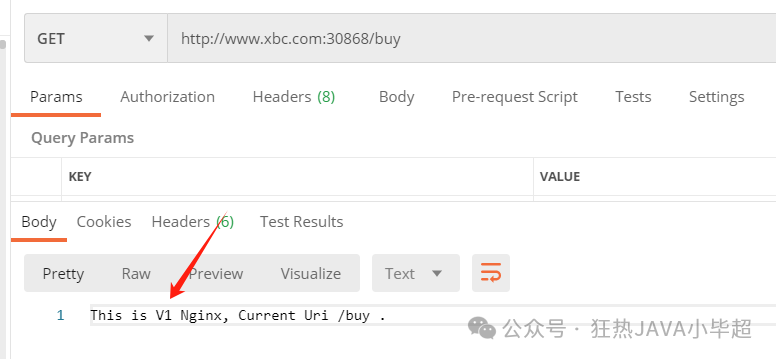
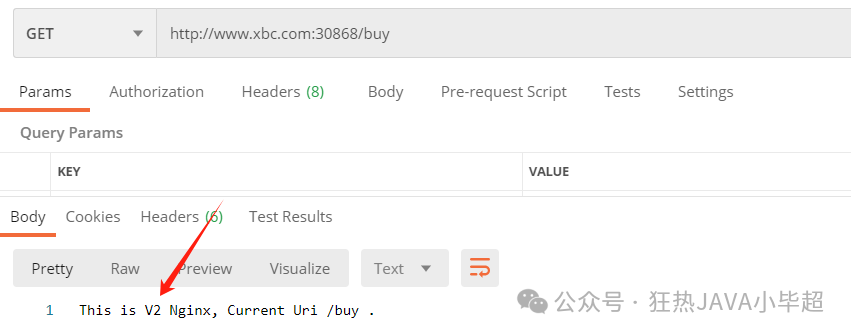
3.2 Traffic Transfer – Transferring Traffic Between Different Versions of the Same Service
In the VirtualService, we introduced weight-based traffic distribution, but for different hosts, combining with DestinationRule allows for more fine-grained control of distribution among multiple versions within a single host, such as controlling 80% of traffic to v1 and 20% to v2.
apiVersion: networking.istio.io/v1alpha3
kind: DestinationRule
metadata:
name: nginx-dr
namespace: test
spec:
host: nginx.test.svc.cluster.local
subsets:
- name: v1
labels:
version: v1
- name: v2
labels:
version: v2apiVersion: networking.istio.io/v1alpha3
kind: VirtualService
metadata:
name: nginx-vs
namespace: test
spec:
hosts:
- "www.xbc.com"
gateways:
- nginx-gw
http:
- match:
- uri:
prefix: /
route:
- destination:
host: nginx.test.svc.cluster.local
port:
number: 80
subset: v1
weight: 80
- destination:
host: nginx.test.svc.cluster.local
port:
number: 80
subset: v2
weight: 20You can loop 10 requests in the console:
for /l %i in (1,1,10) do curl http://www.xbc.com:30868/The results will show that the v1 service received 80% of the traffic.
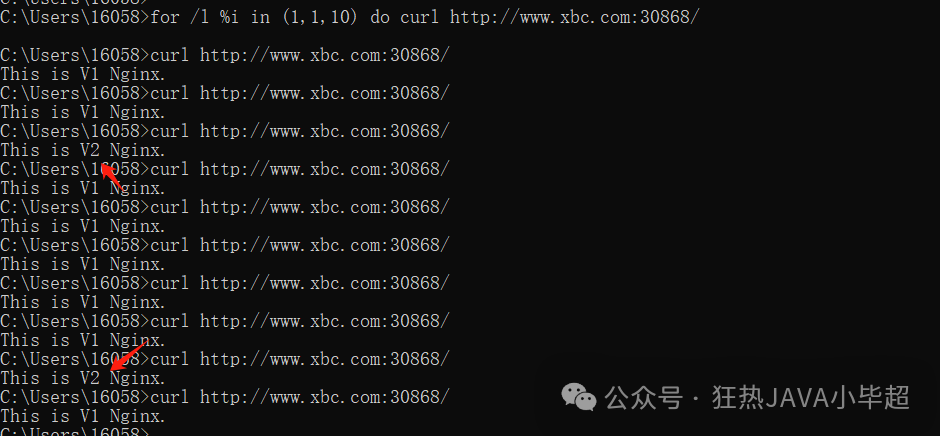
3.3 Connection Pool
The connection pool can be used to control the number of connections sent to the target service, including both TCP connections and HTTP connections.
TCP connection parameters:
-
• maxConnections: Maximum number of connections, default is
1024, also applies toHTTP/1.1;HTTP/2will use a single connection for each host. -
• connectTimeout: Connection timeout.
-
• tcpKeepalive: A new configuration supported after
Istio1.1that periodically sends akeepaliveprobe to the target service to check if the connection is available.
HTTP connection parameters:
-
• http1MaxPendingRequests: Maximum number of pending requests, default is
1024, only applies toHTTP/1.1services. -
• http2MaxRequests: Maximum number of requests, default is
1024. Only applies toHTTP/2services. -
• maxRequestsPerConnection: Maximum number of requests per connection. Both
HTTP/1.1andHTTP/2adhere to this parameter. If not set, it indicates no limit. Setting it to1means that each connection only handles one request, effectively disablingKeep-alive. -
• maxRetries: Maximum number of retries, default is
3. -
• idleTimeout: Idle timeout; if there is no activity within this time, the request will close the connection.
trafficPolicy controls can be specific to a subset:
apiVersion: networking.istio.io/v1alpha3
kind: DestinationRule
metadata:
name: nginx-dr
namespace: test
spec:
host: nginx.test.svc.cluster.local
trafficPolicy:
connectionPool:
tcp:
maxConnections: 1024
connectTimeout: 30s
tcpKeepalive:
probes: 5
time: "3600"
interval: 60s
http:
http1MaxPendingRequests: 2048
http2MaxRequests: 2048
maxRequestsPerConnection: 10
maxRetries: 3
idleTimeout: 60s
subsets:
- name: v1
labels:
version: v1
trafficPolicy:
connectionPool:
http:
http1MaxPendingRequests: 1024
http2MaxRequests: 1024
maxRequestsPerConnection: 10
maxRetries: 3
idleTimeout: 60s
- name: v2
labels:
version: v2
trafficPolicy:
connectionPool:
http:
http1MaxPendingRequests: 1024
http2MaxRequests: 1024
maxRequestsPerConnection: 10
maxRetries: 3
idleTimeout: 60s
3.2 Circuit Breaker
The circuit breaker is a protection mechanism in the Istio service mesh, used to prevent system avalanches and ensure service stability. The Istio circuit breaker mechanism monitors services in real-time, and when it detects that a service has continuous failures, excessive latency, or abnormal responses, it automatically triggers the circuit breaker to prevent further requests from being sent to that service. This can avoid invalid requests from occupying system resources while giving the faulty service time and space to recover.
The circuit breaker functionality in Istio is primarily implemented through the outlierDetection configuration item in DestinationRule, which includes the following configurations:
-
• consecutiveErrors: Indicates that if a service instance returns errors consecutively for a certain number of times within the
intervaltime, that instance will be considered abnormal and trigger the circuit breaker. The default value is5. -
• interval: Defines the statistical time window for
consecutiveErrors. Within this time window, if the failure count of the service instance reaches the threshold ofconsecutiveErrors, the instance will be marked as abnormal. The default value is10seconds. -
• baseEjectionTime: Indicates the minimum time for an abnormal instance to be ejected. Once an instance is ejected, it must wait at least this time before it can rejoin the load balancing pool, even if it becomes available. The default value is
30seconds. -
• maxEjectionPercent: Limits the maximum percentage of instances that can be ejected at the same time. This configuration prevents all instances from being ejected simultaneously, ensuring that the service has a certain level of availability. The default value is
10%.
apiVersion: networking.istio.io/v1alpha3
kind: DestinationRule
metadata:
name: nginx-dr
namespace: test
spec:
host: nginx.test.svc.cluster.local
trafficPolicy:
connectionPool:
tcp:
maxConnections: 100
http:
http1MaxPendingRequests: 100
http2MaxRequests: 100
outlierDetection:
consecutiveErrors: 5
interval: 1m
baseEjectionTime: 1m
maxEjectionPercent: 100
subsets:
- name: v1
labels:
version: v1
- name: v2
labels:
version: v2The above configuration indicates that if an error occurs 5 times within 1 minute, the circuit will be triggered, with a duration of 1 minute, allowing for the ejection of all services.
Next, use the console to concurrently access the /err interface 20 times:
for /l %i in (1,1,20) do start curl http://www.xbc.com:30868/errAfter executing, test accessing the /err interface through PostMan:
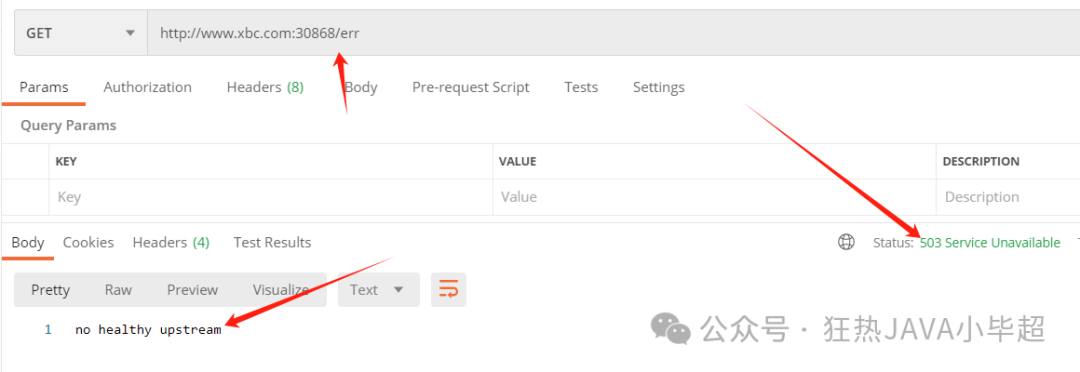
If you access other interfaces, /buy will also be inaccessible because the entire target service has been ejected:
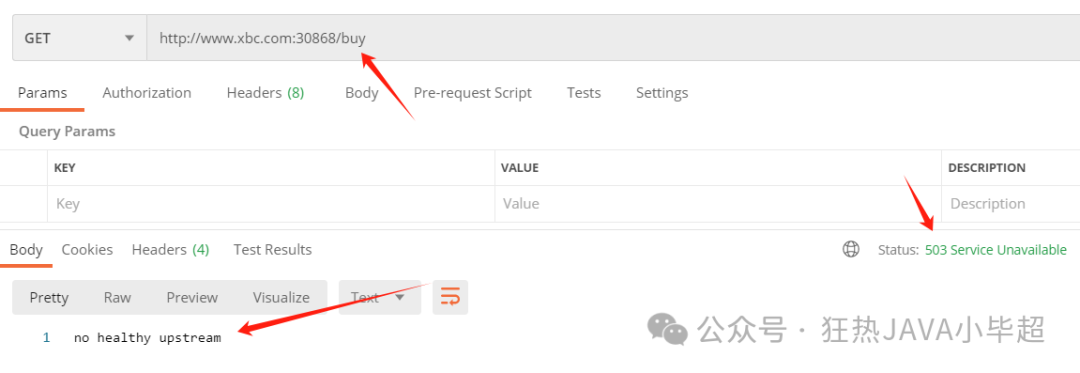
After waiting for 1 minute, accessing again will return to normal:
